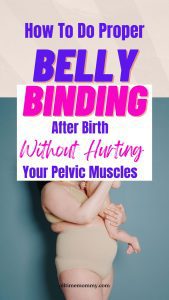Belly binding after birth is an ancient technique that involves tying a stretchy cloth around your abdomen after delivery.
The culture of belly binding after birth emanated from the East, and with time, women worldwide are acknowledging the amazing benefits of this Eastern practice.
Japanese mothers have used their ‘Sarashi’ for postpartum abdominal muscle toning for centuries.
Similarly, in other cultures like the Philippines, Latin America, and Hispanic mothers tie their ‘faja’ around their tummy to compress the abdominal muscles after birth.
And, of course, we, the African women, understand the value of tying a lesso around your tummy after childbirth for abdominal muscle compression.
So,
The big question is…
Does Belly Binding After Birth Work?
Well, mama.
Belly binding after birth works. However, the degree of its effectiveness depends on a number of factors.
- When did you start wrapping your belly after birth?
- How long did you tie your postpartum belly?
- Your main objective of using the belly wrap.
- The type of belly wrap in question.
All these factors will be discussed below, so keep reading.
But before we tackle these issues… You may be wondering
Related: 9 Surprisingly Effective Remedies For Stretch Marks After Birth
Are Belly Wraps the Same as Waist Trainers?
No. A waist trainer is a simple shaping garment that anybody can wear and not necessarily new mothers alone.
Unlike the postpartum belly wraps that are worm to support your abdominal muscles during postpartum recovery, waist trainers are meant to pull a person’s midsection to create a slimmer or smaller waist.
Waist trainers are usually made of tough fabric and hard fibers, while belly wraps consist of soft, stretchy materials that are friendly to a postpartum belly.
Why Use a Belly Wrap After Birth?
Many women may wonder, Why is it important to tie your stomach after giving birth?
Abdominal binding or having a postpartum belly wrap provides excellent support to your back and abdominal muscle after delivery.
It provides gentle compression to the core muscles, which helps the uterus shrink to its normal size more quickly.
During pregnancy, your body stretches, especially the abdominal muscles to accommodate the growing fetus.
As such, tying your tummy after birth can reduce the severity of diastasis recti by helping relax your abdominal muscles, speed up the closure, and ease the pain.
Binding your abdomen and around the hips after birth can support your pelvic floor.
Most Belly wraps also offer gentle compression to your postpartum body, thus, holding muscle and ligaments safely in place as you slowly recover.
In a nutshell, belly binding after birth can help
- Lower the risk of developing diastasis recti by safely Pulling the separated abdominal muscles together.
- Encourages healing by providing support to your pelvic floor muscles
- Reduce air retention in the bowels’ abdomen.
- Reduces the “empty” feeling in your tummy after childbirth.
- Lowers the risk of developing backaches by supporting good sitting and walking posture for a new mom.
When Should You Start Belly Binding?
For belly binding sessions, I begin as soon as I take my first postpartum hot bath, probably on the second day after delivery.
But this is not standard practice as most women who have had a virginal birth find it comfortable to start postpartum belly binding between 3-7.
For a C-section birth, hold on until 4-6 weeks when your incision is healed, before tying your belly.
To be safe.
Consult your professional healthcare provider first, especially if you had complications during childbirth.
How to Wear a Postpartum Belly Wrap
Ideally, you should wear your traditional belly wrap beneath all of your clothes. This will give you the best fit, comfort, and convenience, especially when going to the toilet.
The most effective belly bind stretches from just below your bust to about mid-hip, near your pelvic bone.
Also, be sure to get comfortable postpartum underwear that is easy to pull down and between the wrap.
Why?
Because you’ll need to pull your undie out from under the bind when using the washroom, and when you’re finished, pull them up over the bind or tuck them back underneath.
How Many Hours Should I Tie My Stomach After Delivery?
According to Suzana, a midwife at St. Francis Hospital, you should bind your belly for the entire postpartum “confinement” period.
This is about 40 days or the first six weeks after birth.
You can tie your abdomen to your hips between 6- 10 hours, depending on your feelings.
If you feel quite uncomfortable, which you’ll probably feel, at least try holding on for about 4 hours, then break for an hour or two and repeat the binding.
What makes Traditional belly binding different from modern postpartum girdles?
Mama, your traditional postpartum belly wraps have a custom fit.
Unlike the modern postpartum girdles that only bind your abdomen, traditional wraps like the Malaysian type can wrap your body from under the chest to below the hips.
This way, it doesn’t just work on the belly but also helps the pelvic floor muscles while supporting your back.
Traditional belly wrap is also flexible enough to give you allowance when sitting and stays flexible when you move, so it doesn’t press on the abdomen, so had to interfere with your breathing.
Types of Postpartum Belly Wraps
Postpartum belly wraps come in different types. These include:
Elastic wraps. I like these postpartum wraps because of the elasticity of the fabric. These wraps are made of soft fabrics which are flexible enough to enable you to breathe easily. You only need to ensure that whatever style you get is long enough to wrap around your hips and abdomen comfortably.
Postpartum Support belt. Support belts are external stabilizers that help keep your back and abdominal muscles firm after birth.
Shapewear. Shapewear can also help with postpartum healing. They normally come in full-body suits or high-waisted underwear. Most shapewear are elastic but tight enough to compress your abdominal muscles when healing. Ensure you choose a shapewear style that will not be too tight to interfere with your healing during this postpartum period.
Bengkung Belly Binding
Bengkung belly wrap is a traditional postpartum wrap originating from Malaysia.
These belly wraps feature a lengthy piece of soft cloth that you manually wrap and knot around your abdomen. The piece of cloth should be long enough to cover the hips and run all the way up to just below your bust.
Traditionally, Malaysian women tie bengkung after delivery for physical support.
They believe wrapping your tummy can help hasten postpartum recovery and heal your core muscles.
The ideal length of bengkung fabric ranges between 9 inches wide and 16 yards long. And you may need to wear this wrap for about 12 hours a day for a minimum of 40 days.
Tips for using the traditional belly binding method
- Tie your traditional belly wrap, like Bengkung wraps, directly on your bare skin to make going to the washroom easier.
- Ensure You get a long wrap that covers from under the chest to below the hips. Doing so prevents downward pressure on your pelvic floor muscles that may cause prolapse.
- Always ensure that your traditional wrap is stretchy, comfortable, and doesn’t impede your ability to breathe.
- Try to perform simple tasks like sitting or walking as you tie to ensure your comfort.
- Try to have your traditional belly wrap on while eating. This can help control the amount of food you consume per eating session.
- Give yourself a break. Wearing your postpartum belly wrap all day is not good, as it can weaken your abdominal muscle. As such, give yourself a break in between the day.
When is it too late to wear a postpartum belly wrap?
After three months postpartum, it may be too late to wear a postpartum belly wrap.
I mean, it’s likely that you may not experience the same level of benefit that you would have if you started binding your body earlier in the postpartum recovery journey.
Ideally, if you had a virginal delivery without any complication, you should start wearing your Postpartum belly wraps just a few days after giving birth.
You can wear your wrap at least by the second day and continue doing so for the first 40 days.
Binding your belly within a few days after delivery may be the best option, as the body is intensively healing and preparing to return to a normal state.
In fact, your enlarged uterus is contracting back to its original size and may take about six to eight weeks. No wonder you experience cramping, bleeding, and a heavier-than-normal period.
Also, your abdominal wall muscles are slowly coming together and regaining muscle tone over time.
Additionally, the healing hormones are also active and intensively working to see your body return to normalcy. As such, you may just need to take advantage of your natural healing process to speed up your recovery.
Some women, however, may delay wearing their wraps due to birth methods, like if they had a C-section or complications.
If you are feeling persistent back pain or pain elsewhere, you should stop belly binding and speak with your professional health care provider for assessment.
3 Mistakes to Avoid When Doing Postpartum Belly Binding
Please avoid these mistakes when doing belly binding after birth.
1. Avoid wearing your wraps too tightly.
Postpartum Belly binding is meant to support your abdomen, core, and pelvic floor to help you when healing.
But some women want to use this time to lose their tummies. As such, you may be tempted to tie your tummy tightly.
Do not do this — mama.
Wearing a binder too tightly can lead to excessive pressure on your pelvic floor. This increases your risk of having prolapse and hernias.
2. If you experience Difficulty breathing, Re-adjust
Belly wraps should offer comfort and support. Whenever you experience Difficulty breathing, you struggle to breathe normally, like having shallow breaths when having a postpartum belly wrap. It may indicate that you’re wearing your belly binding too tightly. Take it off and re-adjust.
3. Finding it Difficulty to sit upright and move around, re-adjust
Your belly wrap should be tight enough to give moderate compression to your core but not too tight to interfere with basic activities like sleeping or sitting upright.
Takeaway
Belly binding after birth is a practice that has existed for a long. Most traditional doulas will encourage you to tie a postpartum belly wrap to support your abdominal and pelvic floor muscles during recovery.
Be sure to follow the guidelines to stay safe, even as you incorporate this ancient practice into your daily routine for a quick recovery.
Up Next:
- 7 Best Postpartum Skin Firming Cream
- How To Heal Vaginal Stitches Faster After Birth (Your Complete Checklist)
- 15 Best Home Remedies for Postpartum Fatigue



